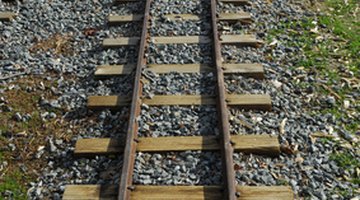How to Terrace With Railroad Ties
Terraces are usually a succession of horizontal steps, like ridges with level tops, built on steep hillsides that would otherwise erode from swift water runoff. Water erosion can cause scarring to steep inclines, leaving gaping gullies and a barren landscape. Terrace landscaping minimizes soil erosion, by allowing the water to soak into the soil and provides landowners the option to create planting beds on steep slopes, according to the National Resources Conservation Service. Terraces frequently require retaining walls to hold back the soil. Because soil is heavy and can shift, it is important that you choose the right materials for retaining walls. Due to their size, weight and durability, treated railroad ties make a good choice.

Step 1
Begin the first tier of your terrace by digging a horizontal trench, at the bottom of your slope, a little wider than your railroad tie. Dig the trench depth about half the thickness of the railroad tie, if your wall height is 2 feet or less. The trench floor should be level and packed tightly, by tamping down the soil.
Step 2
Dig trenches for the sides of the tier. Dig into the slope to create the side trenches. Begin digging at the ends of the horizontal trench. The ends of the ties should meet the horizontal tie ends, forming a corner, on either side of the horizontal tie. When your ties are in place and standing in front of the tier, you should only see the horizontal tie, with the ends of the side ties hidden behind the front railroad tie. Make sure all three trenches are level with one another and that the ground is firm.
Step 3
Place the railroad ties in the trenches. Drill holes about 6 inches from each end of the railroad ties and in each tie center. Drive the 18-inch rods through the holes, into the ground.
Step 4
Excavate the soil, beginning from the back ends of the side railroad ties, to level the ground with the front horizontal tie. This will be the back wall of the first tier and the front wall of the second tier. Place a railroad tie horizontally across the back ends of the first two side ties. The ends should overlap to form joints. Drill through the joints and drive an 18-inch rod through the top and bottom tie. Drill a hole into the center of the horizontal tie and drive an 18-inch tie through the tie and into the ground.
Step 5
Start the second tier. The second tier's horizontal tie is the front wall. Begin digging your second tier side trenches at the ends of the horizontal tie following the process performed in Step 2 through Step 4, until you have the number of tiers you want.
Writer Bio
Gloria Hutson lives in Salem, Mo. She has been writing articles for various websites since 2009. She maintains two blogs that cover craft ideas and genealogical research. She holds a Master of Science degree in justice and security administration from the University of Phoenix and a bachelor’s degree in history from Missouri University of Science and Technology.
Photo Credits
- train tracks image by Richard Paul from Fotolia.com
More Articles



